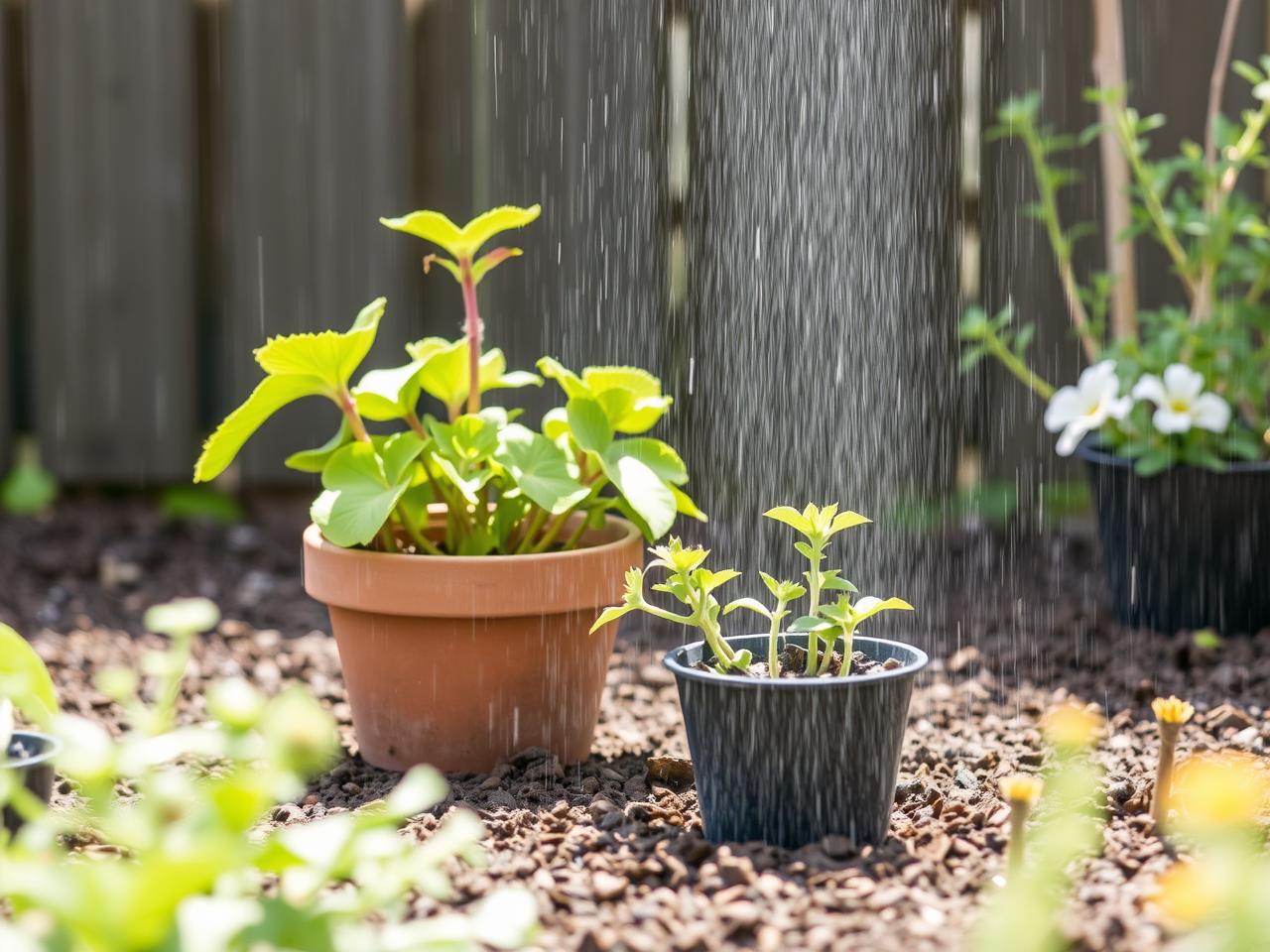Climate-Resilient Gardening: Preparing Your Garden for Extreme Weather Conditions
Climate change significantly impacts gardening and agriculture through increased global temperatures, altered precipitation patterns, and extreme weather events. These changes create challenges for gardeners in maintaining healthy and productive gardens. Warmer temperatures increase evaporation, potentially leading to drought conditions and water scarcity.
Conversely, heavy rainfall and flooding can damage plants and soil health. Rising temperatures also create more favorable conditions for pests and diseases, further complicating gardening efforts. Climate change affects seasonal timing, resulting in earlier springs and later autumns.
This disrupts plants’ natural cycles, impacting their growth and development. Gardeners must understand these changes to adapt their practices and ensure garden resilience. Awareness of climate change impacts enables informed decisions about plant selection, water management, and soil health to mitigate the effects on gardens.
Addressing the impacts of climate change on gardening requires a multifaceted approach. By understanding the challenges posed, gardeners can implement proactive measures to adapt their practices and create resilient gardens capable of thriving in changing environmental conditions.
Key Takeaways
- Climate change can impact gardening through extreme weather events, temperature fluctuations, and changes in precipitation patterns.
- Select resilient plants for your garden that can withstand the challenges of climate change, such as drought-tolerant and heat-resistant varieties.
- Implement water-saving techniques like mulching, drip irrigation, and rainwater harvesting to conserve water and adapt to changing precipitation patterns.
- Create shade and wind barriers using structures, trees, and shrubs to protect your garden from extreme heat and wind damage.
- Build healthy soil for drought resistance by adding organic matter, using cover crops, and practicing no-till gardening to improve soil structure and water retention.
- Protect your garden from extreme heat and cold by providing shade, using row covers, and selecting appropriate planting times for different seasons.
- Develop a sustainable maintenance plan for climate-resilient gardening by practicing integrated pest management, composting, and using natural fertilizers to promote a healthy and resilient garden ecosystem.
Selecting Resilient Plants for Your Garden

Native Plants: A Great Choice for Resilient Gardening
Native plants are often a great choice for resilient gardening, as they are well adapted to the local climate and require less maintenance and resources to thrive.
Drought-Tolerant Plants for Water-Scarce Areas
In addition to native plants, there are many other resilient plant species that can be incorporated into your garden design. Drought-tolerant plants, such as succulents and Mediterranean herbs, are excellent choices for areas prone to water scarcity. These plants have adapted to survive in arid conditions and require minimal watering once established.
Creating a Balanced Ecosystem for Climate Resilience
Selecting plants with strong disease resistance can help reduce the need for chemical treatments and promote a healthier garden ecosystem. Furthermore, incorporating a diverse range of plant species in your garden can help increase its resilience to climate change. By creating a balanced ecosystem with a variety of plants, you can enhance biodiversity and improve the garden’s ability to withstand environmental stressors. Overall, selecting resilient plants is a key step in creating a climate-resilient garden that can thrive in changing environmental conditions.
Implementing Water-Saving Techniques

Water conservation is a critical aspect of climate-resilient gardening, especially in regions prone to drought and water scarcity. Implementing water-saving techniques can help reduce water usage in the garden while maintaining healthy and thriving plants. One effective method for conserving water is through the use of mulch, which helps retain soil moisture, suppresses weed growth, and moderates soil temperature.
Organic mulches such as wood chips, straw, or compost can be applied around plants to reduce evaporation and minimize the need for frequent watering. Another water-saving technique is the use of efficient irrigation systems, such as drip irrigation or soaker hoses, which deliver water directly to the root zone of plants. This targeted approach reduces water waste from evaporation and runoff, ensuring that plants receive adequate moisture while minimizing water usage.
Additionally, incorporating rainwater harvesting systems can help capture and store rainwater for later use in the garden, reducing reliance on municipal water sources. Furthermore, practicing smart watering habits, such as watering early in the morning or late in the evening to minimize evaporation, can also contribute to water conservation efforts. By being mindful of water usage and implementing efficient watering techniques, gardeners can reduce their environmental impact while promoting the resilience of their gardens in the face of climate change.
Creating Shade and Wind Barriers

Creating shade and wind barriers in the garden is essential for protecting plants from extreme heat, strong winds, and other environmental stressors associated with climate change. Shade structures such as pergolas, arbors, or shade cloth can help reduce the intensity of sunlight and heat exposure, providing a more favorable environment for plants to thrive. These structures not only offer protection from excessive heat but also create comfortable outdoor spaces for gardeners to enjoy.
In addition to shade structures, planting windbreaks using trees, shrubs, or hedges can help mitigate the damaging effects of strong winds on garden plants. Windbreaks act as natural barriers that reduce wind speed and turbulence, protecting plants from wind damage and desiccation. When selecting plants for windbreaks, it’s important to choose species with strong root systems and flexible branches that can withstand high winds without breaking.
Furthermore, incorporating vertical gardening techniques such as trellises or espaliered fruit trees can help create microclimates that offer protection from harsh environmental conditions. These techniques not only maximize space in the garden but also provide opportunities for creating sheltered areas that promote plant growth and resilience. Overall, creating shade and wind barriers is an important strategy for enhancing the climate resilience of your garden and ensuring the well-being of your plants.
Building Healthy Soil for Drought Resistance
Building healthy soil is fundamental for creating a resilient garden that can withstand drought conditions and other environmental stressors associated with climate change. Healthy soil with good structure and organic matter content has better water retention capacity, which is essential for supporting plant growth during dry periods. Incorporating organic matter such as compost, leaf mold, or well-rotted manure into the soil can improve its ability to hold moisture and provide essential nutrients to plants.
In addition to organic matter, using mulch on the soil surface helps conserve moisture by reducing evaporation and maintaining consistent soil moisture levels. Mulch also promotes soil health by suppressing weed growth, moderating soil temperature, and enhancing microbial activity. These benefits contribute to the overall resilience of the garden ecosystem and support plant growth even in challenging environmental conditions.
Furthermore, practicing sustainable soil management techniques such as minimal tillage and crop rotation can help maintain soil structure and fertility while reducing erosion and nutrient depletion. These practices contribute to the long-term health of the soil and its ability to support plant growth under varying climate conditions. By building healthy soil with good water retention capacity and nutrient availability, gardeners can create a foundation for drought-resistant gardening that promotes the well-being of their plants.
Protecting Your Garden from Extreme Heat and Cold

Shading Techniques for Extreme Heat Protection
One effective strategy for protecting plants from extreme heat is through shading using shade cloth, umbrellas, or temporary structures such as row covers or cold frames. These shading techniques help reduce the intensity of sunlight exposure and provide relief from high temperatures.
Watering and Mulching for Heat Stress Relief
In addition to shading, providing adequate moisture through regular watering is crucial for helping plants cope with extreme heat stress. Watering deeply and infrequently encourages deep root growth and improves the plant’s ability to access moisture during hot weather. Using mulch around plants also helps conserve soil moisture by reducing evaporation and maintaining consistent soil moisture levels.
Protecting Plants from Extreme Cold
Protecting plants from extreme cold requires proactive measures such as using frost blankets or row covers to insulate them from freezing temperatures. These protective coverings help trap heat around plants and prevent frost damage during cold snaps. Additionally, planting cold-hardy varieties and providing wind protection using windbreaks or other barriers can help minimize the impact of extreme cold on garden plants. Overall, protecting your garden from extreme heat and cold is essential for promoting the resilience of your plants and ensuring their well-being in changing environmental conditions.
Developing a Sustainable Maintenance Plan for Climate-Resilient Gardening
Developing a sustainable maintenance plan is crucial for ensuring the long-term resilience of your garden in the face of climate change. A sustainable maintenance plan encompasses various aspects of gardening practices, including water management, soil health, plant care, pest control, and overall garden management. By integrating sustainable practices into your maintenance plan, you can create a resilient garden that thrives in changing environmental conditions while minimizing its impact on the surrounding ecosystem.
One key aspect of sustainable maintenance is water management, which involves efficient watering techniques, rainwater harvesting, and water conservation measures such as mulching. By optimizing water usage in the garden, you can reduce reliance on municipal water sources while promoting healthy plant growth even during drought conditions. In addition to water management, promoting soil health through organic matter incorporation, minimal tillage, and crop rotation is essential for creating a resilient garden ecosystem that supports plant growth under varying climate conditions.
Healthy soil with good structure and nutrient availability contributes to the overall resilience of the garden while reducing the need for chemical inputs. Furthermore, implementing integrated pest management (IPM) practices that prioritize natural pest control methods over chemical treatments helps maintain a balanced ecosystem while minimizing environmental impact. By fostering biodiversity through plant selection and habitat creation, you can encourage natural predators that keep pest populations in check without relying on harmful pesticides.
Overall, developing a sustainable maintenance plan for climate-resilient gardening involves integrating water-saving techniques, promoting soil health, implementing natural pest control methods, and prioritizing biodiversity to create a resilient garden ecosystem that thrives in changing environmental conditions while minimizing its impact on the environment.
FAQs
What is climate-resilient gardening?
Climate-resilient gardening involves designing and maintaining a garden to withstand and adapt to extreme weather conditions, such as heatwaves, droughts, heavy rainfall, and strong winds, that are becoming more common due to climate change.
How can I prepare my garden for extreme weather conditions?
To prepare your garden for extreme weather conditions, you can take steps such as selecting resilient plant species, improving soil health and drainage, using mulch to retain moisture, and providing shade and wind protection for vulnerable plants.
What are some examples of resilient plant species for climate-resilient gardening?
Resilient plant species for climate-resilient gardening include native plants, drought-tolerant plants, and those that can withstand temperature fluctuations and heavy rainfall. Examples include succulents, ornamental grasses, and certain types of shrubs and trees.
How can I improve soil health and drainage in my garden?
You can improve soil health and drainage in your garden by adding organic matter such as compost and mulch, using raised beds or mounded planting areas, and incorporating permeable materials like gravel or pavers to reduce runoff and erosion.
What are some strategies for providing shade and wind protection in a garden?
Strategies for providing shade and wind protection in a garden include planting windbreaks such as hedges or trees, using shade cloth or pergolas, and positioning taller plants to shield more delicate ones from strong winds and intense sunlight.







